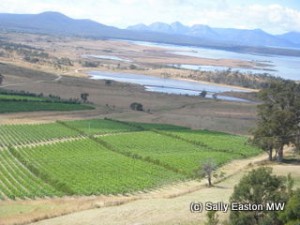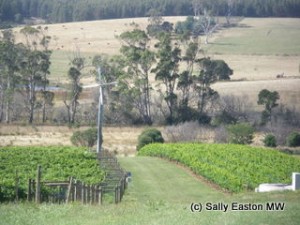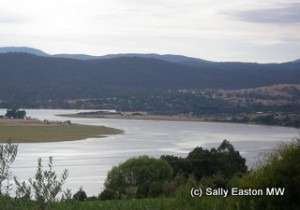Tassie pinot noir

East coast Tas
With 42% of total Tasmanian vineyard plantings, pinot noir is the island state’s lead variety. There are nearly twice as many hectares of pinot noir as next most popular grape variety, chardonnay, and while a sizeable chunk of all of this is fed into sparkling wine production, still red pinot noir wine is getting to be a force to be reckoned with, with even latent sub-regional undertones becoming apparent.
Such a trend is perhaps not that surprising given the variations in climatic parameters across north, east and southern Tassie. And notwithstanding the huge level of experimentation with pinot noir, such as at Frogmore, a broad, generalised profile for Tassie pinot noir might be, said René Bezemer, chief winemaker at Kreglinger Wine Estates, “floral attributes, delicate perfume and distinctive fruit aromas … violets, darker berry fruit, dark cherry. I look for a palate with a viscous feel, juicy, and with depth of fruit.”
Digging further into this perfumed cool climate style of pinot noir, Fran Austin of Delamere Vineyards, also in northerly Pipers River said “pinot noir regions in Tasmania are spread out. The climate, soil, and clones overlap to make wines from each vineyard distinctive.
“The east coast, with its higher humidity and narrow range of temperature, is riper than Pipers River, and not as soft and generous as Tamar Valley. But they are quite powerful and concentrated.” On the east coast, Claudio Radenti of Freycinet Vineyard, who makes some of the island’s leading pinot noir, said he plants his “pinot noir on north facing slopes for warmth”, adding some other sites in the area are at risk of spring frosts. Generally, though, the east coast is marginally warmer.
In the south, Austin said Coal River Valley is comparable to Tamar [in the north], making delicate wines focused on perfume” though Coal River “is pure, primary, and floral.” Coal River, said Jeremy Dineen, winemaker at Josef Chromy in the north, “is in the rain shadow of Mount Wellington. Annual rainfall is 500 to 600mm.” Then within Coal River, he added “around Campania is higher up, it’s warmer at day, cooler at night.”
Huon Valley sits to the west of Hobart, on the exposed, windward, west side of Mount Wellington. Austin said “rainfall is high, and it’s cold. You have to be so careful about site selection.” This area of apples and cherries is significantly colder with regular frost risk, and so far remains a hideout for hardy producers making tiny volumes.

Pipers River, north Tas
Up in the north of the island, Pipers River, north-east of Launceston gets up to 300m above sea level, and has mostly a maritime climate with high humidity. Austin said pinot noir here “is high in acidity, with fresh raspberry and tomato leaf characters. Cooler fruit characters with taut acidity and tannin line.”
On the north-west side of Launceston, Tamar Valley is more moderate and not far above sea level. There’s more maritime effect with consequently much lower frost risk than other areas. Here, Austin said pinot noir “has softer, riper, sweeter, red berry fruits, which are quite primary; you don’t always see the florals. And tannins range from gentle to quite big and robust.”
Even though Tamar is 50 km from Pipers, Bec Duffy of Holm Oak added her home territory of Tamar has “more warmth, fruit ripens a week before Pipers River.” This helps to explain, she added, why “there’s a lot of sparkling in Pipers River.” At Holm Oak, Duffy said they also consistently ripen cabernet sauvignon, a month after pinot noir.
Forming a developing triangle with Tamar and Pipers, Relbia is further south, inland and with a hundred metres of altitude. Dineen said “it’s cooler overnight and daytime temperature is 1-2°C cooler than at Kayena [on the Tamar peninsula]. We get delicate red berry fruits rather than dark berry fruits [of Tamar], and rather than herbal, spicy Pipers River characters.”

Tamar river, north Tas
Among other things, vine age was cited as a contributing factor to emerging styles, as many vineyards are just about coming into maturity. Joe Holyman of Stoney Rise / Holyman said “young-vine fruit gives pretty aromas, strawberry, and older vine fruit from here [Tamar] fills out the palate.”
Whatever these emerging differences, pinot noir is on a roll in Australia, and cooler climate expressions of Australian pinot noir are building up a real head of enthusiastic steam around the world. Tas is the coolest place Australia has got, and Austin pinpointed the moment “in 2005 [when] it clicked with the industry that pinot noir had potential in Tas.” Sure does.
My research visit to Australia in February 2012 was sponsored by Wine Australia and Wine Tasmania.



